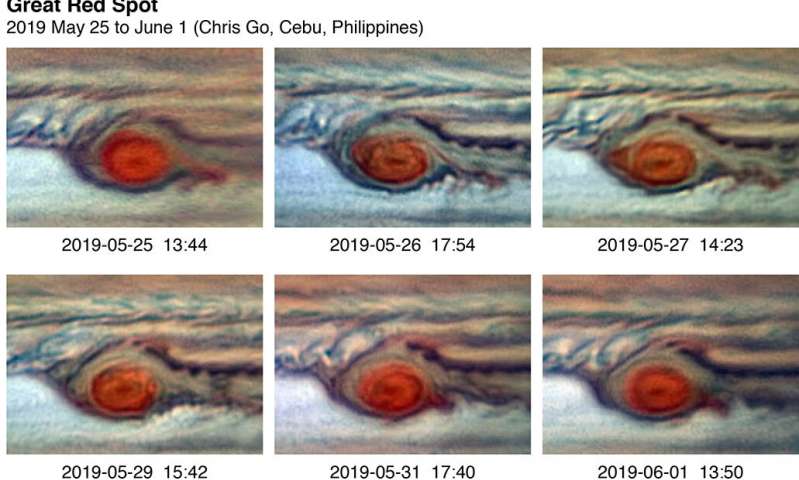At https://phys.org/news/2019-11-jupiter-great-red-demise-greatly.html … reports of the demise of Jupiter's Great Red Spot are greatly exaggerated we are told. It seems visible clouds hide the true size and nature of the vortex and it is not shrinking as alleged earlier this year. Philip Marcus has a session at the American Physical Society's 72nd annual meeting, with the title, 'The Shedding of Jupiter's red flakes does not mean it is dying.' In the spring of 2019 observers and photographed large red flakes being ripped from the familiar red spot (or the one we had grown used to). Marcus says flaking is a natureal state of a vortex with cloud coverage and not an indication of the spot's death. Another bit of alarmism spiked. He adds, quoting Mark Twain, reports about its demise have been greatly exaggerated. It seems smaller cloud formation bumped into the red spot creating stagnation points. Velocity seemed to stop and restart and go off in different directions. These points indicate where an approaching cloud shattered and created the flakes (as seen by astronomers). The loss of undigested cloud fragments through encounters with stagnation points does not signify its demise etc.
Marcus went on to say a secondary circulation, driven by the heating and cooling above and below the vortex, allows the great red spot to continue to exist over the centuries, fighting off decay of its energy from viscosity, turbulence, and heat loss.
 ..
..
Meaznwhile, at https://phys.org/news/2019-11-ice-fossils-meteorite.html … ice found in a meteorite by Japanese, Chinese, and UK scientists. The picked up in the Algerian mountains back in the 1990s and has been analysed by different groups looking for different things – mainly clues on the origin of the universe. The latest study appears in Science Advances (Nov 2019) – see https://doi.org/10.1126/sciadv.aax5078 … which of course would mean that the parent object (from which the meteorite split from) possessed water – in one form or another. The discovery of ice crystals (or what look very much like ice crystals) may imply the existence of water at the outset of the solar system. However, the assumption is now that water arrived on earth via space, but from the outer regions of the solar system (on formerly cold objects). The paradox here is that once they passed what is called the snow threshold, where heat from the sun dissipates water (into vapour), and leaves behind water crystals as evidence of its passage into the inner solar system, is there any water left to feed the oceans? I suppose this is what happens when you are balancing a mainstream mantra (water arrived from space) with facts on the ground (in this case a meteorite). In one respect you are upsetting the applecart and in the other you are trying to keep it from falling over. What we don't know of course is for how long that meteorite has been flying around the inner solar system. The ice crystals could have formed as a result of repeated heating episodes. However you look at it there was no water left in which to supply earth with water.
